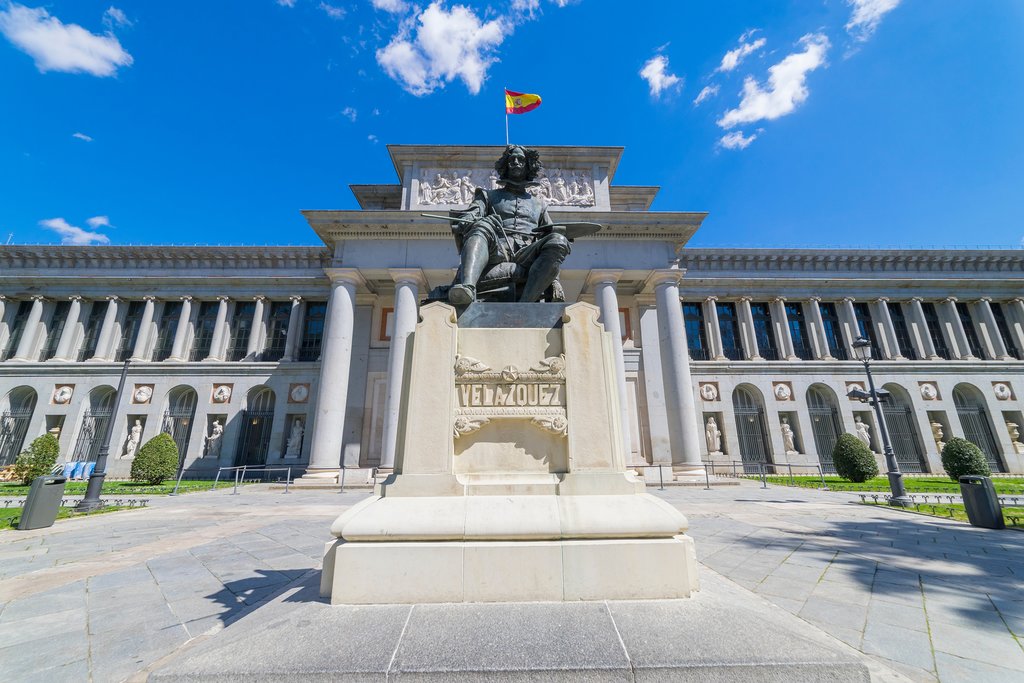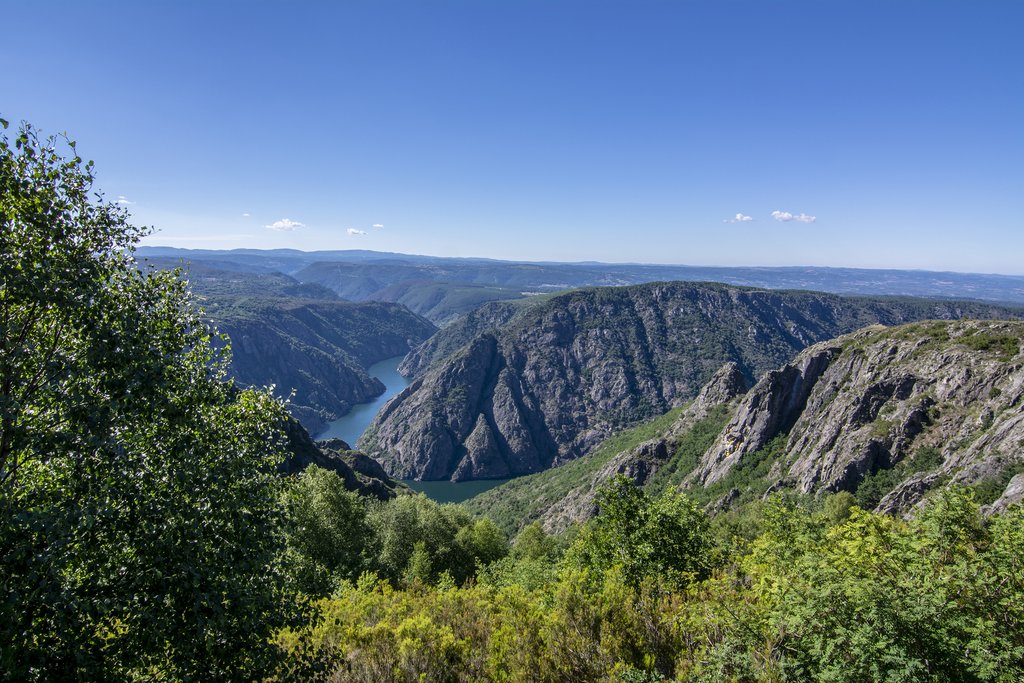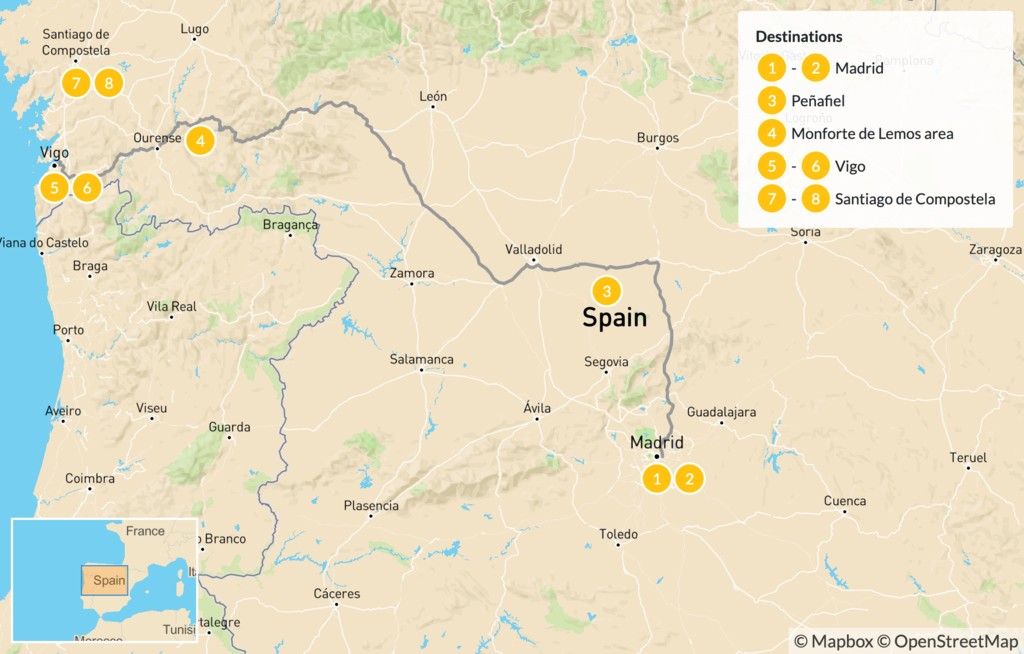Highlights
- See the most famous sites of Madrid on a guided walk
- Visit the Ribera del Duero wine region
- Travel the pilgrimage route and stop at beautiful locales in Galicia
- Enjoy the white-sand beaches of the Cíes Islands
Brief Itinerary
| Day | Highlights | Overnight |
|---|---|---|
| Day 1 | Arrive in Madrid, Evening Tapas Experience | Madrid |
| Day 2 | Madrid's Highlights, Prado Museum & Foodie Walk | Madrid |
| Day 3 | Drive to Ribera del Duero | Peñafiel |
| Day 4 | Drive to Ribeira Sacra via Astorga | Monforte de Lemos |
| Day 5 | Boat Ride in Ribeira Sacra, Drive to Vigo | Vigo |
| Day 6 | Day Trip to the Cíes Islands | Vigo |
| Day 7 | Drive to Santiago de Compostela via the Camellia Route | Santiago de Compostela |
| Day 8 | Santiago de Compostela Cooking Class & City Walk | Santiago de Compostela |
| Day 9 | Depart Santiago de Compostela |
Detailed Itinerary
Day 1: Arrive in Madrid, Evening Tapas Experience

Welcome to Spain! Upon arrival at the nation's capital, you'll enjoy a private transfer to your hotel in the city center. Take some time to settle in before heading out to explore highlights like the Puerta del Sol, one of the city's most historic and expansive plazas. There's also Madrid's famous Fountain of Cibeles, with its 18th-century sculpture depicting Cybele, the Greek goddess of fertility, riding in a chariot pulled by lions.
In the evening, you'll dig into Madrid's culture on a two-hour walking excursion that stops at some great tapas bars. On this walk, you'll visit Barrio Las Letras, which is known as the "literary quarter." This historic neighborhood in the city center was once home to Spanish literary legends like Cervantes and Quevedo. Besides visiting some historic sites around here, you'll also stop at Calle Huertas for a bite at one of the many tapas bars that line the street.
Day 2: Madrid's Highlights, Prado Museum & Foodie Walk

After breakfast, a private guide will pick you up from your hotel and take you on a half-day walk through the city. This excursion covers all the highlights of Madrid's long history, from the times of the Habsburgs and the Bourbons to the present day. This includes a stop at the opulent Royal Palace, the former residence of the King and Queen of Spain. You'll also visit the expansive Plaza Mayor, the shopping area along Gran Vía, and a stroll through El Retiro Park, the "green lung" of Madrid.
The tour ends with a visit to the magnificent El Prado Museum, which features one of the world's finest collections of European art. This includes works by Velazquez, El Greco, and Goya. Your guide will lead you through some of these exhibits before leaving you to continue exploring on your own. There's a lot to see, as the galleries here are home to masterpieces from the Spanish, Italian, and Flemish schools.
After the museum, you'll have a break to relax and recharge after all that walking. Then, you'll head out for an evening hopping from one great tapas bar to another. These classic taverns have defined Madrid for centuries, and at each one, you'll be treated to delicious and authentic Spanish food. Your guide will accompany you and offer insight into this cuisine as well as which wines pair best with certain dishes.
Day 3: Drive to Ribera del Duero

In the morning, you'll pick up your rental car and drive north from Madrid for two hours toward Valladolid, a medieval city known for its Gothic churches. This route heads deep into Spain's Old Castile region, famous for its high plateaus and mountain scenery. It was once the heart of the Kingdom of Castile, which thrived in the 11th century, and its old castles stand to this day. You'll see one fortress, Peñafiel Castle, when you arrive in the town of the same name.
The town of Peñafiel sits in the Ribera del Duero wine region. This fertile grape-growing area enjoys Designation of Origin (DO) status, a certification reserved only for the top wine-producing spots in the country. It has earned this appellation, too, as the wines from Ribera del Duero rival those produced in Spain's most popular viticulture region, La Rioja.
Upon arrival in Peñafiel, you'll check into a hotel located right on the vineyards. You'll have the rest of the day to enjoy the hotel's amenities or head out for some fresh air and a walk among the grapevines. You could also venture into Peñafiel for a self-guided walk. From the expansive Plaza del Coso, you can see the famous castle overlooking the town.
Chat with a local specialist who can help organize your trip.
Day 4: Drive to Ribeira Sacra via Astorga

Today you'll drive west from Ribera del Duero into the Galicia region of Spain. Not only is Galicia regarded as one of the most beautiful parts of the country, but it's also the end of one of the most famous walks in the world: the Camino de Santiago. This ancient network of pilgrimage routes begins as far away as France and leads to the cathedral in Galicia's capital of Santiago de Compostela, where the apostle Saint James the Great is supposedly buried.
You'll pass some of these incredible landscapes as you drive through the Galician countryside to the Ribeira Sacra region. The rivers Sil and Miño wind through the green mountains of this unspoiled area, which is dotted with monasteries and hermitage sites that date back to when the first Christians arrived in the 12th century. The name Ribeira Sacra actually translates to "Sacred Riverbank."
First, stop in the village of Astorga, the capital of Maragatería County. Stone walls dating to Roman times encircle Astorga; within them, you'll find many medieval churches, convents, and hospitals. On a guided walk, you'll see landmarks like the town square (Plaza Mayor de Astruga) and Episcopal Palace. This late-19th-century modernist masterpiece by Antoní Gaudí is one of only three buildings designed by the legendary architect that exists outside of Catalonia.
After walking around Astorga, you can stop at a restaurant for a traditional lunch. Be sure to try a Galician specialty like a roast suckling pig or polbo á feira (boiled octopus with paprika and olive oil). Other regional favorites include caldo gallega (a hearty broth of potatoes, beans, greens, and pork), fried padrón peppers, and queso de tetilla, a soft, cone-shaped white cheese known for its buttery taste. Afterward, continue to the Ribeira Sacra region and your hotel, located near the town of Monforte de Lemos.
Day 5: Boat Ride in Ribeira Sacra, Drive to Vigo

You'll have the day to enjoy the Ribeira Sacra, a mountainous river canyon of unparalleled beauty. Remote and lesser-developed than many parts of Spain, since the 12th century, this area was primarily home to monks and hermits who came to live ascetic lives near the confluence of the rivers Sil and Miño. The River Sil winds between green mountains and through canyons, affording some incredible views of sloping hills, high plateaus, cypress and chestnut trees, and grapevines.
Ribeira Sacra is a fertile grape-growing region that enjoys Designation of Origin (DO) status for its wine production. It's uniquely referred to as "heroic viticulture" because most vineyards here are terraced due to the steepness of the mountains and hills. With so many vines hanging off the sides of hills and canyons, the simple act of grape harvesting in Ribeira Sacra requires much dexterity and agility.
After the boat ride, you'll head to a local guesthouse, where the friendly hosts will prepare a homemade meal for you to enjoy. Then you'll hop back in the car and drive a couple of hours west to the coastal city of Vigo, where you'll spend the night.
Day 6: Day Trip to the Cíes Islands

About 10 miles (16 km) west of Vigo, off the coast of Spain, lie the Cíes Islands. This archipelago is a national marine park comprised of three islands so beautiful that the ancient Romans called them the "islands of the gods." Two of them, Monte Agudo and O Faro, are linked by a crescent strip of fine white sand called Rodas Beach, one of the most beautiful beaches in the world. You'll get to discover this paradise on a private, day-long boat tour accompanied by an expert guide.
In the morning, you'll depart from the port at Vigo and head to a group of nearby Spanish fjords known as Rias Bajas. These beautiful inlets serve a functional purpose in that it's here where Galicians harvest much of their famously delicious shellfish. The microclimate in the waters of these fjords makes an ideal breeding ground for scallops as well as perfect spots to cultivate mussels and oysters.
After stopping on the islands for some beach time and light hiking, you'll enjoy lunch onboard the ship. This will be a delicious gourmet meal featuring locally sourced products, including some of that world-class shellfish. Afterward, you'll return to Vigo and will have the remainder of the day free to enjoy however you wish.
Day 7: Drive to Santiago de Compostela via the Camellia Route

In the morning, you'll hop in the car and begin the hour-long drive north from Vigo to Santiago de Compostela. But first, you'll stop to smell the flowers—literally. The region of Galicia is home to over 8,000 varieties of camellia, a far-east plant typically found in China and Japan. Spain began importing them in the 18th century to fill the gardens of Galician aristocrats. Eventually, they spread to public green spaces, too.
Accompanied by a guide, you'll drive along the Route of the Camellia, a network of flower-rich areas in the provinces of Galicia. You'll stop at some of the most ornate camellia gardens in rural pazos (country homes), where you can admire the various colors in bloom. It's a beautiful and sweet-smelling detour into the world of Galician flora.
In the afternoon, you'll reach Santiago de Compostela. This historic city is Galicia's capital and the culmination point of the Camino de Santiago. Upon arrival, you'll check into your hotel and have the remainder of the day free.
Day 8: Santiago de Compostela Cooking Class & City Walk

In the morning, you'll discover the secrets to Galician cuisine in a cooking class with a private chef. You'll prepare (and eat) some of the region's most popular dishes, like fried padrón peppers and savory empanadas stuffed with fish, shellfish, or meat. Be sure to try queimada, the famous "Galicia fire drink." Made with a liqueur called orujo (similar to grappa), it's mixed in a clay bowl with sugar and lit on fire until the flame turns blue, then served hot.
In the afternoon, you'll embark on a guided walk to the main sites in Santiago. This includes Obradoiro Square and the Cathedral of Santiago de Compostela. Construction on this Romanesque/Gothic/Baroque church began in the 11th century over the site of what is believed to be the burial place of the apostle Saint James the Great. It's been a religious pilgrimage site since the Middle Ages and marks the end of the famous Camino de Santiago walking route.
Other stops include Colexio de San Xerome (San Jerónimo College), a learning institution dating to 1501; the 16th-century Hospital de los Reyes Católicos, a hospital built to treat weary pilgrims after their arduous journey; the Pazo de Raxoi (Raxoi Palace), an 18th-century neoclassical palace that's now Santiago's City Hall; and the 18th-century San Fructuoso Church. Here you can witness pilgrim rituals and see the Botafumeiro.
Day 9: Depart Santiago de Compostela

It's time to say farewell to Spain! Depending on your flight or train reservation, squeeze in one more morning of sightseeing, perhaps picking up some last-minute souvenirs. At the designated time, you will be picked up at your hotel and transferred to the airport or rail station for your departure.


